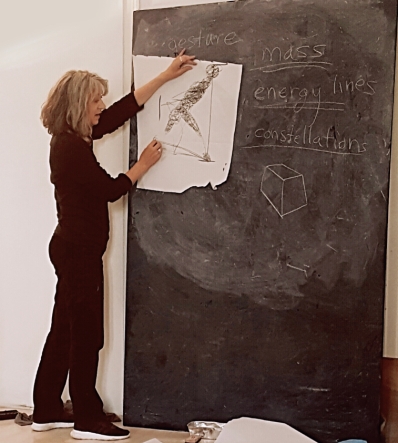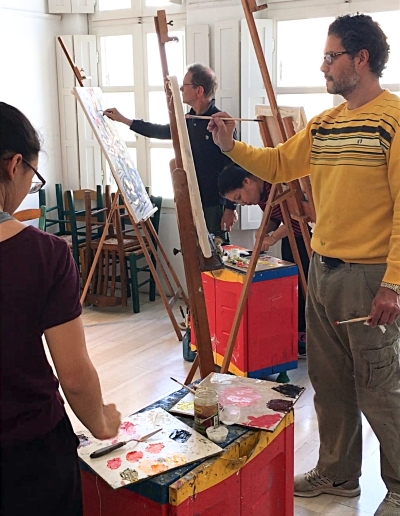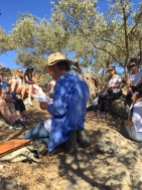Which Ancient Philosopher Are You?
31, December 2019 § 2 Comments
Epicureanism. Living gracefully within the garden of nature.
The Aegean Center students and staff spend a month each fall living and studying in the Villa Rospigloisi, in Pistoia, Italy. Besides classes in drawing and photography, we learn about Renaissance art and travel most days to see masterworks, returning with gratitude each evening to our villa in the hills. We often linger in the garden in the hours before dinner, watching the light play over the 400 year old magnolia trees, listening to the fountain splash and enjoying the aroma of food coming from the kitchen. We have few distractions, plenty of time to converse, and delicious home cooked meals. The combination of study and simple living create a joyous and rewarding month.
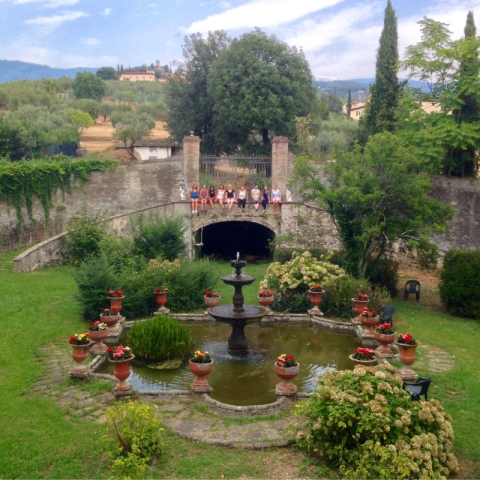 Our Villa Garden in Tuscany
Our Villa Garden in Tuscany
The fact that we are studying in Italy and Greece compels me to introduce a short conversation about ancient philosophers to my students. To make this interesting we read short synopses of seven different philosophies of the ancient world and see which of these resonates with their ideas of how to live a good life. Through a series of questions most of my students this term decided that they identified with Epicureanism. One student decided he was a nihilist, though that wasn’t on the list, and a few were drawn to Neoplatonism.
Epicurus was a 3rd BCE philosopher who believed that through elimination of fears and desires (ataraxia) people would be free to pursue simple pleasures to which they are naturally drawn. His followers were known as the Garden People and worked to banish superstition and cultivate a rational understanding of nature. Unlike many other philosophical discourses, women were allowed and urged to join his circle. Epicureans felt that discovering simple pleasures and living a prudent life leads to the greatest social happiness, that understanding the power of living within nature’s limits was essential. The word Epicureanism is misunderstood now as advocating hedonism but the philosopher himself said that a person can only be happy and free by living wisely, soberly, and morally. He said, “Nothing is enough for the man for whom enough is too little”. Our intention is to create an arts program with echos of this joyful search for individual happiness. We stress living with few material requirements, eating food prepared with pure ingredients and being in nature. We have no pretensions to luxury and yet we provide a wonderfully rich and fruitful atmosphere in which students can achieve their best . When simple wants are satisfied we have a deeper appreciation for the aesthetics aspects of life, of beauty, of art.
 Epicurus
Epicurus
In contrast to my students, I tend toward the Stoic philosophy. Again, modern understanding of this philosophy misinterprets Stoicism as merely censoring strong emotions. Marcus Aurelius and Epitectus elucidate the philosophy of Stoicism as a guide to find peace; integrity being the chief good. Epitectus said, ““Happiness and freedom begin with a clear understanding of one principle: Some things are within our control, and some things are not. It is only after you have faced up to this fundamental rule and learned to distinguish between what you can and can’t control that inner tranquility and outer effectiveness become possible.” What he believed was true education consists in recognizing that each individual has their own will and cannot be compelled or hindered by anything external. He felt that individuals are not responsible for the thoughts that arrive in their consciousnesses though they are completely responsible for the way in which they use them. “Two maxims,” Epictetus wrote, “we must ever bear in mind—that apart from the will there is nothing good or bad, and that we must not try to anticipate or to direct events, but merely to accept them with intelligence.”
 Filigree of Wildflowers on Paros
Filigree of Wildflowers on Paros
And, “Wisdom means understanding without any doubt that circumstances do not rise to meet our expectations. Events happen as they may. People behave as they will.” Finding that my ideals on how to live aligned best with the Stoics I also realised it aids my teaching; empowering me to honour each individual‘s place in the hierarchy of learning, reconfirming that competition has never been an effective teaching tool. I also recognise that what I say and what I teach will be taken by each student to mean what they interpret it to be and not always what I have said. Patience and being an attentive listener are paramount in a teacher but Stoicism also illustrates that 14 different students will have 14 different approaches to a given lesson. Each student will need specific help to elicit their best qualities. It’s not about meeting my standards as much as it is about their comprehension. And, of course, a teacher must accept that each group has its own personality. Fortunately in this group, they were mostly Epicureans by nature.
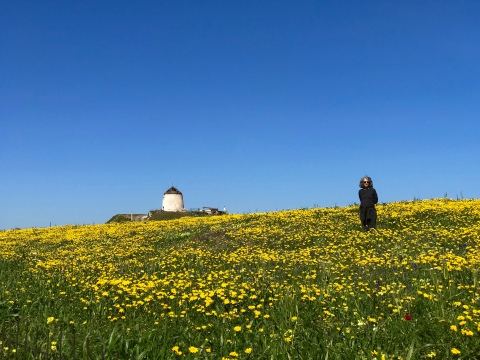 Yellow & Blue Paros Spring
Yellow & Blue Paros Spring
Half Way
29, October 2016 § Leave a comment
 Clearing Storm at the end of a brilliant day
Clearing Storm at the end of a brilliant day
As the last days of October come in with clouds and cold winds, we have arrived at our half term break. Some of the students will be travelling, but the majority of the group are choosing to stay in Paros to work in the studios and the digital lab. It has been a busy and event filled semester. After returning from Italy we introduced the landscape of our lovely island with several hikes, the first was a walk above Lefkes to the inner valley beyond the windmills. There among the olive trees John read an entry from his journal from the time he lived on the Navajo Reservation in Arizona. It never fails to move his audience and this time there was a deep quiet as he finished. His words touched us all.
 John reading from his journal under the olive trees
John reading from his journal under the olive trees
Last weekend we sailed around Antiparos with Captain Tasso and had a meal at Zombos, a restaurant at the southern end of the island facing Despotico. We had just strolled about the new excavations of the ancient temple, getting a glimpse into the working of the restorers who are rebuilding the facade of the temple. The winds came up as we finished our meal and Captain Tasso felt we needed to start back to avoid the oncoming storm. It caught up with us anyway and we all got wet, but the students sang and huddle together and we were rewarded with a full rainbow as we turned the corner toward Paros and home.
A few days ago Dimitra Skandalis gave a guest lecture on her work just before she returned to her new home in San Francisco. She shared her ideas and her passions with students and brought along some samples of the work she does with seaweed. She is a former student who is originally from Paros. Her exhibition at the school this summer was her first solo show here on the island.
Now with a much needed break to consolidate information and clarify goals, the students will come back to finish the semester work and prepare to display their efforts for the final exhibition in the first week of December.
 Cliffs of volcanic detritus on the backside of Antiparos.
Cliffs of volcanic detritus on the backside of Antiparos.
 Enjoying the Rain…Hoddies!
Enjoying the Rain…Hoddies!
:Thanks, Ken Shiozawa, for the photos and being Student Extraordinaire
Annelise Grindheim’s Drama
10, July 2016 § 1 Comment
by: Jeffrey Carson
The origins of drama are mysterious. But my intuition suggests that all drama starts in awe of the world, its powers and unseen powers, its passions and irresolutions. Drama has its roots in religion, cult, magic, poetic rapture, birth/sex/death, and natural wonder. I think this is true of anonymous Passion plays from the Middle Ages, Shakespeare’s investigations of everything human and beyond, ghostly Japanese Noh, rollicking Restoration comedy, throbbing opera, and even the great realist works of the last century-and-a-half, whose master is Henrik Ibsen.
I did not mention ancient Greek plays because these astonishing works – we have thirty-two of them – seem to know this about themselves, and consciously embed themselves in primitive ritual and, with music and poetry, political realism.
The Aegean Center’s drama teacher, Anneliese Grindheim, knows these things, and her love and understanding of the Greek plays informs her work here on Paros. Last autumn she produced a condensed version of Lorca’s frightening tragedy, “The House of Bernarda Alba”, which, in image-loaded verse, shows what happens when society’s rules try to squelch the natural joy and passion of life. Working with small forces – students and a few local friends – Annelise trimmed the work to its essentials – she has an amazing ability to do this with respect and accuracy.

Annalise Grindheim
This spring’s work was even more ambitious. It was Ibsen’s “Lady from the Sea”, a realist drama. Redacting again, Annelise found the poetry and intensity curled deep in the Norwegian master’s realism (she is Norwegian herself). The play is a liminal work, and we are never sure what will happen as the symbols keep being transformed. The actors performed it on the beach, sometimes on sand, sometimes in water. The growth of the heroine’s soul and self into maturity, and its salutary effect on her husband, were aided by movements derived from dance, by declamation derived from poetry, by masks, and by the sea itself – wavelets, gulls, breezes, briny clarity. Liminal indeed.
I’m fortunate to work at the Aegean Center with such skilled practitioners of their arts as John Pack, Jane Pack, Jun-Pierre Shiozawa, and most recently, Annelise Grindheim. What will she come up with next? I may write a poem about it.
Summer Oil Painting Workshop 2016
30, June 2016 § 1 Comment
The Aegean Center summer workshop, Oil Painting Innovations, concluded this last Saturday with a successful exhibition at the Center. The five painters showed four paintings each, sharing the space with the watercolour and the photography students from the other workshops. The walls were crowded with excellent work all of which showed a high level of skill and aesthetic involvement.The painting class followed several historical methods chosen for their instructive value; Venetian heightening with white on a dark ground from the 15th century, Flemish floral painting from the 17th century and Impressionist still life from the 19th century. These methods were explained and then explored in order for the students to maximize their understanding of the principals of structured oil paintings. A fourth exercise, which dealt with the painting of an all white still life, was chosen to challenge color mixing choices and the necessary lowering of tone which oil paint dictates.
The process of hand refined linseed oil which we began using a year ago at the Center was demonstrated and became our medium. It’s unique properties allow us to forgo solvents. The oil is stronger and shinier than the store bought tube oils. The handling is fluid, each touch is recorded. It creates a tough film, maintains textural elements of brushwork and keeps its color integrity when painting wet into wet. We were in the studios every day for six hours six days a week. The new oil paint made it possible for us to continue working without the need for long drying times and so the layers went on quickly. Working on four canvases with different criteria kept us energized. Thank you to my students for their enthusiasm and their dedication.

Erin Jones
Clean Monday / Καθαρά Δευτέρα
14, March 2016 § 1 Comment
Clean Monday, Καθαρά Δευτέρα, is celebrated today here in Greece. It is the first day of Lent when the faithful begin 40 days of fasting in preparation for Easter.
Traditional foods are served which emphasis austerity and deprivation to echo the fasting of Christ in the desert. In Paros the devout eat pickles, food without oil, and animal flesh only without blood such as kalimari and octopus. Eggs, dairy and meat are absent from the table. These rules make sense for an agricultural society which must protect the brooding chickens and the young goats and cows so as to assure the next generation. There will be kite flying and family picnics if the weather is good, being out of doors allows us to witness a burgeoning spring with the world returning to abundance and production after the winter’s hush. Here on the island we have a winter that is most gentle and verdant, the deprivations others face with cold and snow are less known to us. We watch the re-emergence of new leaves on the deciduous trees resembling butterflies emerging from their chrysalis. We observe the prancing young goats and lambs. We contemplate the new growth which is all around making us aware of the cycles of nature, potent harbingers of life and rebirth.

“Lagana / Λαγάνα” the special azyme bread baked only on Clean Monday.
Greeks are asked to give up luxuries during this time. Many people no longer conform to the strict diets but I feel there is something important about denying ourselves our indulgences. We grow accustomed to having far more than is necessary for our existence. Every year I try to find something which I think I need but which is not essential to my survival and give it up for 40 days. I have denied myself at various times chocolate, coffee, wine and sweets. None of these posed a particular problem for me. Far more difficult was the challenge to give up complaining which I did not manage. This year I have decided to quit looking at the daily news feed in the mornings. I find it wastes at least one to two hours of time that I would otherwise fill with more imaginative pursuits. Beginning every morning with the anxious headlines is addictive but not ultimately uplifting or productive. Perhaps I will simply sit with my coffee and dream, with luck I will begin a creative project. And so my yearly fast begins.
The Spring Semester 2016
8, March 2016 § Leave a comment

The first week of the spring semester is underway and students are attending their initial classes in order to make a decision about which areas to concentrate in. It’s exciting and everyone is hoping to do more than they can practically handle. All will settle in, as usual, by the end of next week.
We have students from China, India, Norway, Canada and the US as well as Greek students so we are truly an international community. The faculty are currently evaluating the level of each student and adapting their teaching to accommodate and facilitate the abilities of each. With a small group this is not only easy but also vital to our philosophy of individualized instruction. The Socratic method, first used and explored by the Greek philosopher of that name, is our modus operandi. We pose open ended questions, allow for personal interpretations and expect impassioned and imaginative answers. The digital photography class has several returning students who will bring their experience and expertise to elevate the level of the instruction. The same holds true for painting where three of the students are second or third term students who can share opinions and aesthetic ideas. This Friday our first hike will take place above the town of Lefkes in the valley behind the windmills. Afterward we will all share a taverna meal at Flora’s. After all, eating well is part of a life well lived.
Flaxseed Oil, Psyllium Husk, A Bit of Chalk, Oil Paint & Pinch of Risk…
27, March 2015 § 1 Comment
I wrote a few notes to myself at the beginning of this semester about what I expect from students in my classes. These include a desire that they engage deeply with their work, that they find ways to discuss their progress and their process. I want them to take more responsibility for their learning, to risk more and to be able to play with the material to allow spontaneity. I place similar demands on myself as an artist and an educator. This semester is no exception. I am introducing a new painting method which involves hand refined linseed oil and chalk. This method is somewhat complex at the beginning to explain but allows for more freedom and energy in the paint handling. I wondered what details I need to add and when and how they would adopt the information I was giving them. Would they be able to handle the complexities of the system? All my energies are devoted to communicating clearly the nuances and the particulars.
I take a risk altering my teaching methods each semester. There are some moments that feel as though I were on a high wire without a net. I prepare my lessons but go off in various directions as the moment takes me. I throw away the script and sometimes improvise wholesale. I suppose all teachers with years of experience can do this but I have often felt that vertiginous drop in the lower stomach when you realize you are in free fall. But I am willing to take the chances and the students benefit. I’m not bored and hopefully neither are they.
Hand refined oil and chalk as additions to painting have been researched by Louis Velasquez and Tad Spurgeon, each of whom have valuable insights into this historical method. It involves purifying the organic flax seed oil with alcohol and using psyllium husks to hold and retain the mucilage which is released from the oil. I have been playing with it for just about a year and I find it redefines oil painting. It requires some investment in time for the preparation of the oil but speeds up the painting process considerably as the oil dries quickly and with great body and gloss. It creates effects which resemble early master works which I have been unable to achieve with modern manufactured paint. I felt it was worth the extra work and effort to introduce this new paint to students. As it is my first semester doing so, I await their results before I can judge. The risk will probably pay off, but at any rate allowing the students to watch me take the risk could be just as instructive.
Delphi
30, April 2013 § 3 Comments
During the middle of each semester the Aegean Center for the Fine Arts takes a week long pause from classes. The mid semester break provides an opportunity for students and faculty alike to travel to parts near and far from Paros. This post is a collection of notes on my travels to Delphi in Central Greece during mid-April.
-Jun-Pierre Shiozawa, instructor of painting
Gods
Legendary, mythical Delphi, where the two eagles of Zeus rejoined after circling the world. Where the Sybil sat atop her stone and the oracle foresaw Alexander’s conquests. It is the seat of Apollo, slayer of the monstrous Python at the Kastalian Spring below Mount Parnassus. Where Dionysios arrives to winter when Apollo departs every year to the land of the Hyperboreans. Delphi is a place of Gods, the Omphalus, the navel of the earth.
At the Archaelogical Museum of Delphi, a figure stands erect and alone. He is a young man. His skin, hair and robe are bronze and his lips and long eyelashes are copper. He holds reins in his right hand, writhing in static motion though disconnected from horses that escaped their charioteer long ago. There is another figure all but gone, save for his bronze left arm. It is delicate and thin, held forever upwards in a gesture resembling adoration or prayer. The charioteer looks outward and inward, a victorious champion, proud and reserved.
Today, surrounding the charioteer is a sea of faces, rapt, reaching up in the same gesture as the attending slave, arms above their heads, phones and cameras in hand.
The homogenization of site-seeing
At the archaeological site, large tour groups assemble, noisy and sprawling. Languages from around the world call out as visitors organize themselves. At this entry point the ancient, mysterious site of Delphi feels oddly familiar. This can happen when visiting any other stop on the tour of famous sites around the world, from Times Square to the Taj Mahal. With the ticket stands, gift shops, cafes and crowds, the packaging is all the same from one place to the next.
Integration
In harmonious accord among the cypress trees and the ridges of Mount Parnassus lie the ruins of Delphi. It is not a very big site. As it ascends one climbs from temple to temple. Large marble blocks sprout from the earth like wild flowers. The ancient stones nestle into the mountain. They do not feel alien to this landscape, instead they remind one of how a bird’s nest integrates with a tree. It looks perfect in precisely the spot where it sits.
Sound and silence
Midway up between the temple of Apollo and the ancient theater the voices that echo over the valley of Phocis take on a new shape. One still hears the din of foreign tongues, but the color of the sound transforms in every way, in volume, frequency and expressive quality. The noise of the chatter at the entry gate is pulled, thinned, mellowed and spread over the landscape like honey. Past the Temple of Apollo, the cacophony finds a metronome and harmony of low voices, hushed tones and pauses: the sound of people in awe. It plays in concert with the steady hum of the place. High above the site at the theater the music is ever present, a chorus of humans, birds, bumblebees and winds.
When looking down past all of the ruins and over the great valley one feels they are receiving a gift, sacred and timeless. A gift that is too immense to be contained and must be shared. The sharing of this gift takes the form of silent appreciation from one stranger to the next–raising of the eyebrows, shaking of the head, deep inhalation and release of breath, a smile. The silence communicates in a way in which words never can: that we are only human and we are here but for a moment.
Questions and Answers
Humbled, visitors walk down and out of the ancient sanctuary of Delphi. Passengers pack in to buses and we continue on our individual journeys through the world, lives busy and full.
Home of the Delphic Oracle, travelers have long come to Delphi seeking answers to their questions. Yet what we find in Delphi it is not a place to answer all the questions, but a place to reflect on them.
An Open Letter from Caroline Robe
13, December 2012 § Leave a comment

Dear John, Jane, and Jun– my lovely teachers from a year ago–
It is true that everything changes for the better after a time at the Aegean Center. Looking back one year ago we were hanging that final show. This week I am hanging my university’s final show. I can only hint at the personal growth, joy, and creative productivity that has occurred between the two. I know that this incredible moment, which is yet unfinished, began while I was on Paros immersed in what I can retrospectively see is one of the best and most unique communities that exist anywhere. Paros opened me to loving a place, loving a craft, and loving myself, and those lessons have continued to guide me as I make my way back in the States. Thanks to all of you for that.
I didn’t know it then but the time spent in Italy and watching Jane and Jun do their painting work gave me a strong interest in narrative and classical technique. When I came back in the winter I began studying egg tempera and have been working with it since then. I was also awarded a scholarship to go study fresco this summer, and now work in both. Early in the year I started on my Honors thesis, a year-long independent project in the student’s discipline. My thesis is the work I am hanging in the show and I will be defending it to my committee in two weeks time.
I wanted to share this with you because I feel it shows how much I absorbed while in Italy and Greece and the tremendous impact you have on your students. I think of you all and things you have taught me often. From you, John, I think of lessons about midtones, I am not even joking. I truly want to make the midtones in the paintings sing. I also think to really see things and appreciate. From you, Jane, I think of lessons about the figure, some tips on glazing, and how to be a woman and an artist all at once. From you, Jun, I remember many painting techniques learned, and I see how to be a young figurative painter with verve. All these lessons and more went into completing this project.

The painting project I conceived for my thesis is a narrative polyptych “afterpiece” in egg tempera. I wanted to explore the process and flow of bliss, vernacular space here in Orono, and feminine creative power. I started painting early this spring and finished last week. The painting is eight feet wide and five and half feet tall, structurally organized as a hinged triptych, with multiple paintings on each panel. There is silver leafing in the sky and I built the frame in a timber-frame style, learning much about carpentry! It is almost a house in itself. The center panel mimics annunciation paintings, but with a twist. The bottom panel is a hell montage inspired by Bosch. The outer two are symbolic landscapes compiled from my town here.

That’s all. I’m so happy to share this with you and to look back a year ago and remember it all.
As for the future, I am graduating in December, working on my portfolio this spring and summer, and headed out for residencies in the fall. I am applying to some in the states but really hoping to get over to Europe where I can learn more about the sort of painting I am interested in.
My best wishes to all of you, and thank you, thank you, thank you,
Caroline
http://carolinerobe.com/

